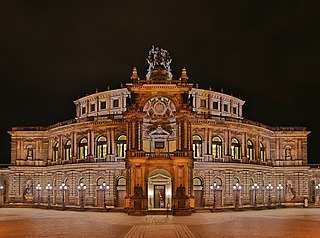Related Research Articles

Heinrich Isaac was a Netherlandish Renaissance composer of south Netherlandish origin. He wrote masses, motets, songs, and instrumental music. A significant contemporary of Josquin des Prez, Isaac influenced the development of music in Germany. Several variants exist of his name: Ysaac, Ysaak, Henricus, Arrigo d'Ugo, and Arrigo il Tedesco among them.

The Staatskapelle Dresden is a German orchestra based in Dresden, the capital of Saxony. Founded in 1548 by Maurice, Elector of Saxony, it is one of the world's oldest and most highly regarded orchestras. Its precursor ensemble was Die Kurfürstlich-Sächsische und Königlich-Polnische Kapelle. The orchestra is the musical body of the Staatsoper Dresden. The venue of the orchestra is the Semperoper.

Antonio Caldara was an Italian Baroque composer.

Heinrich August Marschner was the most important composer of German opera between Weber and Wagner.
Antonio Scandello was an Italian composer, born in Bergamo. He worked as musician at the court of the Electors of Saxony in Dresden. In 1549 he became court-bandmaster, and in 1568 Kapellmeister succeeding Mattheus Le Maistre. His music combines elements of the Italian Renaissance with German musical traditions.

Conradin Kreutzer or Kreuzer was a German composer and conductor. His works include the operas Das Nachtlager in Granada and incidental music to Der Verschwender, both produced in 1834 in Vienna.
Heinrich Finck was a German composer.

Johann Crüger is known as a German composer of well-known hymns. In reality, he was an ethnic Sorb, baptized as Jan Krygar. He was also the editor of the most widely used Lutheran hymnal of the 17th century, Praxis pietatis melica.

Paul Hofhaimer was an Austrian organist and composer. He was particularly gifted at improvisation, and was regarded as the finest organist of his age by many writers, including Vadian and Paracelsus; in addition he was one of only two German-speaking composers of the time who had a reputation in Europe outside of German-speaking countries. He is grouped among the composers known as the Colorists.
"Innsbruck, ich muss dich lassen" is a German Renaissance song. It was first published as a choral movement by the Franco-Flemish composer Heinrich Isaac ; the melody was probably written by him. The lyricist is unknown; an authorship of Emperor Maximilian I, as was previously assumed, seems highly unlikely.
The year 1648 in music involved some significant events.
Heinrich Schwemmer was a German music teacher and composer.

Johann Nepomuk Fuchs was an Austrian composer, opera conductor, teacher and editor. His editorial work included an important role in the preparation of the first complete edition of Schubert's works. He was an older brother of the composer Robert Fuchs.
Jacob Regnart was a Flemish Renaissance composer. He spent most of his career in Austria and Bohemia, where he wrote both sacred and secular music.
Johann Rudolph Ahle was a German composer, organist, theorist, and Protestant church musician.
Johann Baptist Singenberger was a Swiss composer, music teacher, editor and publisher. Much of his output was devoted to Catholic liturgical music. He was reckoned to have taught over 1,000 musicians in his lifetime. In 1873 Singenberger founded the American St. Cecilia Society, an organization belonging to the Cecilian movement which sought to revive the spirit of the masses and motets of Palestrina. Singenberger was also a professor of music at the Catholic Normal School in St. Francis, Wisconsin.

Maximilian Johann Karl Dominik Stadler, Abbé Stadler, was an Austrian composer, musicologist and pianist.
Giuseppe Antonio Brescianello was an Italian Baroque composer and violinist.
Alexander Utendal was a Flemish composer.

The four Tantum ergo, WAB 41, are settings of the hymn Tantum ergo composed by Anton Bruckner in 1846.